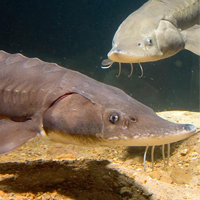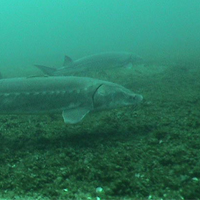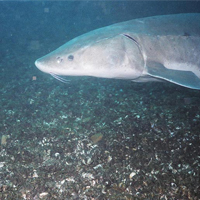Lake sturgeon (Species at Risk)
Scientific name: Acipenser fulvescens




Status
Endangered (Great Lakes - Upper St. Lawrence populations)
“Endangered” means the species lives in the wild in Ontario but is facing imminent extinction or extirpation.
Threatened (Saskatchewan - Nelson River populations)
“Threatened” means the species lives in the wild in Ontario, is not endangered, but is likely to become endangered if steps are not taken to address factors threatening it.
Special Concern (Southern Hudson Bay - James Bay populations)
"Special concern" means that the species lives in the wild in Ontario, is not endangered or threatened, but may become threatened or endangered due to a combination of biological characteristics and identified threats.
Date added to the Species at Risk in Ontario List
Lake Sturgeon was listed as special concern when the Endangered Species Act took effect in 2008. On September 10, 2009 the species was divided into three distinct populations and listed as threatened (Great Lakes - Upper St. Lawrence and Northwestern Ontario populations) and special concern (Hudson Bay - James Bay population). The Great Lakes - Upper St. Lawrence populations were reassessed as endangered in November 2017.
Read the assessment report PDF.
What it looks like
The Lake Sturgeon is Canada’s largest freshwater fish, weighing up to 180 kilograms and reaching over two metres long. It has an extended snout with four whisker-like organs hanging near the mouth.
Its body is covered with large bony plates, pronounced in juveniles but less pronounced in larger fishes. It is dark to light brown or grey on its back and sides with a lighter belly.
Unlike other fish found in Ontario, the Lake Sturgeon has a skeleton made up of cartilage instead of bones. The Lake Sturgeon has ancestral ties to related species dating back 200 million years. It can live more than 100 years.
Where it lives
The Lake Sturgeon lives almost exclusively in freshwater lakes and rivers with soft bottoms of mud, sand or gravel. They are usually found at depths of five to 20 metres.
They spawn in relatively shallow, fast-flowing water (usually below waterfalls, rapids, or dams) with gravel and boulders at the bottom.
However, they will spawn in deeper water where habitat is available. They also are known to spawn on open shoals in large rivers with strong currents.
Where it’s been found in Ontario
In North America, Lake Sturgeon can be found from Alberta to the St. Lawrence drainage of Quebec and from the southern Hudson Bay to the lower Mississippi.
In Ontario, the Lake Sturgeon is found in the rivers of the Hudson Bay basin, the Great Lakes basin and their major connecting waterways, including the St. Lawrence River.
There are three distinct populations in Ontario: Great Lakes - Upper St. Lawrence, Saskatchewan - Nelson River, and Southern Hudson Bay - James Bay.
What threatens it
Historically, harvesting, dams and other river barriers, habitat loss, and poor water quality were responsible for the decline of Lake Sturgeon throughout North America.
With improvements in water quality and the strict regulation or elimination of commercial and recreational fishing of Lake Sturgeon in Ontario, habitat fragmentation and regulated water flows from dams are the greatest threats to the species.
Action we are taking
Lake Sturgeon (Great Lakes - Upper St. Lawrence populations)
- Endangered species and their general habitat are automatically protected
Lake Sturgeon (Saskatchewan - Nelson River populations)
- Threatened species and their general habitat are automatically protected
Lake Sturgeon (Southern Hudson Bay - James Bay populations)
- Special concern species do not receive species or habitat protection, but may be eligible for grants to help with their protection and recovery.
Recovery strategy / Management plan
Recovery strategies that are developed for more than one population of a species, meet the requirements for a management plan for those populations that are classified as Special Concern (e.g., Common Five-lined Skink and Lake Sturgeon).
Read the executive summary (December 7, 2011)
Read the recovery strategy (December 7, 2011)
Habitat protection
General Habitat Protection – September 10, 2009 for threatened populations (Saskatchewan - Nelson River) and August 2, 2018 for endangered populations (Great Lakes - Upper St. Lawrence).
What you can do
Report a sighting
Report a sighting of an endangered animal or plant to the Natural Heritage Information Centre. Photographs with specific locations or mapping coordinates are always helpful.
Volunteer
Volunteer with your local nature club or provincial park to participate in surveys or stewardship work focused on species at risk.
Be a good steward
- private land owners have a very important role to play in species recovery; if you find Lake sturgeon on your property, you may be eligible for stewardship programs that support the protection and recovery of species at risk and their habitats - for more information, visit:
www.ontario.ca/speciesatrisk. - invasive species seriously threaten many of Ontario’s species at risk; to learn what you can do to help reduce the threat of invasive species, visit:
www.ontario.ca/invasivespecies
www.invadingspecies.com. - farmers and land owners can help improve fish habitat and keep Ontario’s water safe and clean by maintaining natural vegetation next to creeks and rivers, and keeping pollution and soil from washing into Ontario’s streams and rivers; for more information about programs and funding assistance for eligible land owners, visit the Ontario Soil and Crop Improvement Association website at
www.ontariosoilcrop.org/en/programs/species_at_risk.htm.
Report illegal activity
Report any illegal activity related to plants and wildlife to
Quick facts
- the oldest known specimen of Lake Sturgeon is 155 years old from Lake Huron; the largest Lake Sturgeon recorded was from the Roseau River of Manitoba, weighing 185 kg and measuring 4.6 m in length
- the inner lining of the Lake Sturgeon’s swim bladder (an air-filled sac that helps the fish float) was used to clarify wine, beer and other liquids
- subsistence fishing for Lake Sturgeon is a long-standing tradition for many Aboriginal communities
- Lake Sturgeon are migratory and travel upstream to spawning grounds and downstream to deeper water during the summer; some adults travel up to 400 km to spawning areas